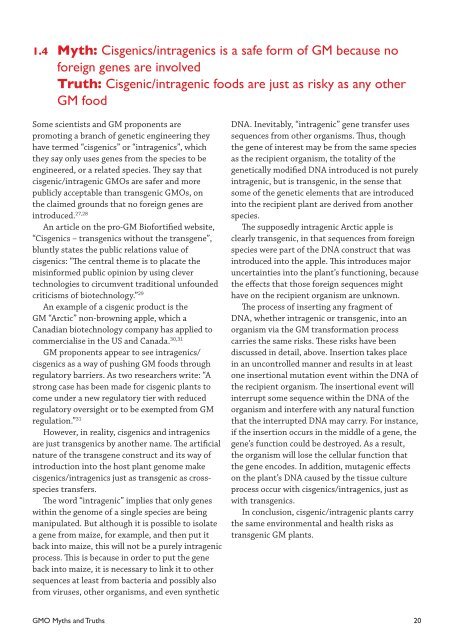GMO Myths and Truths
GMO Myths and Truths
GMO Myths and Truths
Create successful ePaper yourself
Turn your PDF publications into a flip-book with our unique Google optimized e-Paper software.
1.4 Myth: Cisgenics/intragenics is a safe form of GM because no<br />
foreign genes are involved<br />
Truth: Cisgenic/intragenic foods are just as risky as any other<br />
GM food<br />
Some scientists <strong>and</strong> GM proponents are<br />
promoting a branch of genetic engineering they<br />
have termed “cisgenics” or “intragenics”, which<br />
they say only uses genes from the species to be<br />
engineered, or a related species. They say that<br />
cisgenic/intragenic <strong>GMO</strong>s are safer <strong>and</strong> more<br />
publicly acceptable than transgenic <strong>GMO</strong>s, on<br />
the claimed grounds that no foreign genes are<br />
introduced. 27,28<br />
An article on the pro-GM Biofortified website,<br />
“Cisgenics – transgenics without the transgene”,<br />
bluntly states the public relations value of<br />
cisgenics: “The central theme is to placate the<br />
misinformed public opinion by using clever<br />
technologies to circumvent traditional unfounded<br />
criticisms of biotechnology.” 29<br />
An example of a cisgenic product is the<br />
GM “Arctic” non-browning apple, which a<br />
Canadian biotechnology company has applied to<br />
commercialise in the US <strong>and</strong> Canada. 30,31<br />
GM proponents appear to see intragenics/<br />
cisgenics as a way of pushing GM foods through<br />
regulatory barriers. As two researchers write: “A<br />
strong case has been made for cisgenic plants to<br />
come under a new regulatory tier with reduced<br />
regulatory oversight or to be exempted from GM<br />
regulation.” 31<br />
However, in reality, cisgenics <strong>and</strong> intragenics<br />
are just transgenics by another name. The artificial<br />
nature of the transgene construct <strong>and</strong> its way of<br />
introduction into the host plant genome make<br />
cisgenics/intragenics just as transgenic as crossspecies<br />
transfers.<br />
The word “intragenic” implies that only genes<br />
within the genome of a single species are being<br />
manipulated. But although it is possible to isolate<br />
a gene from maize, for example, <strong>and</strong> then put it<br />
back into maize, this will not be a purely intragenic<br />
process. This is because in order to put the gene<br />
back into maize, it is necessary to link it to other<br />
sequences at least from bacteria <strong>and</strong> possibly also<br />
from viruses, other organisms, <strong>and</strong> even synthetic<br />
DNA. Inevitably, “intragenic” gene transfer uses<br />
sequences from other organisms. Thus, though<br />
the gene of interest may be from the same species<br />
as the recipient organism, the totality of the<br />
genetically modified DNA introduced is not purely<br />
intragenic, but is transgenic, in the sense that<br />
some of the genetic elements that are introduced<br />
into the recipient plant are derived from another<br />
species.<br />
The supposedly intragenic Arctic apple is<br />
clearly transgenic, in that sequences from foreign<br />
species were part of the DNA construct that was<br />
introduced into the apple. This introduces major<br />
uncertainties into the plant’s functioning, because<br />
the effects that those foreign sequences might<br />
have on the recipient organism are unknown.<br />
The process of inserting any fragment of<br />
DNA, whether intragenic or transgenic, into an<br />
organism via the GM transformation process<br />
carries the same risks. These risks have been<br />
discussed in detail, above. Insertion takes place<br />
in an uncontrolled manner <strong>and</strong> results in at least<br />
one insertional mutation event within the DNA of<br />
the recipient organism. The insertional event will<br />
interrupt some sequence within the DNA of the<br />
organism <strong>and</strong> interfere with any natural function<br />
that the interrupted DNA may carry. For instance,<br />
if the insertion occurs in the middle of a gene, the<br />
gene’s function could be destroyed. As a result,<br />
the organism will lose the cellular function that<br />
the gene encodes. In addition, mutagenic effects<br />
on the plant’s DNA caused by the tissue culture<br />
process occur with cisgenics/intragenics, just as<br />
with transgenics.<br />
In conclusion, cisgenic/intragenic plants carry<br />
the same environmental <strong>and</strong> health risks as<br />
transgenic GM plants.<br />
<strong>GMO</strong> <strong>Myths</strong> <strong>and</strong> <strong>Truths</strong> 20


